Nelson's Column in Trafalgar Square, statue by H. J. Baily
Statue of Nelson, Trafalgar Square.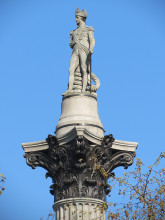
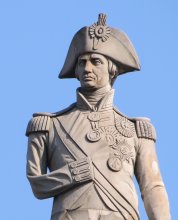
Nelson's column is one of the most famous pieces of sculpture in London, appearing on countless emblematic skylines of the capital. By contrast, few today will have heard of the sculptor, E.H. Baily, who had been a pupil of the better known John Flaxman. This page is about the statue, the column, and notes some other statues of Nelson across England. The lions at the base of the column, and other things in Trafalgar Square, are covered in other pages on this website.
One of London's most iconic statues (see this page for a list), Nelson's Column in Trafalgar Square was put up in 1843 (work on the column had started two years before), and stands about 150 ft tall. The statue of Nelson, also dated 1843, at the top of the Corinthian column is by the sculptor E.H. Baily, and is itself about 18ft high, the large size being necessary to keep the figure in proportion with the column and for it to be appreciated from down below.
Of course we cannot appreciate it that much from down below, as the angle of view is much too oblique (see the picture on the Trafalgar Square page); the best views are from the sides of Trafalgar Square, or down the roads leading off it, or further away than that and on higher ground, where there are views between or over buildings. Trafalgar Square itself is on a slope, and the higher North side, on the steps to the National Gallery, gives a somewhat elevated view of the Column, but then we are looking at Nelson s back, for he gazes down Whitehall towards Parliament, the South, and the sea where he won his famous battles. From other directions, at middle distance, the unaided eye is caught by the silhouette of the statue with the characteristic tricorn hat against the sky; yet further away, the distant column and by then miniature figure are a point of reference to identify this part of London.
Baily's statue of Nelson, different views.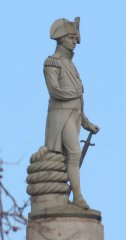
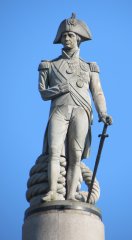
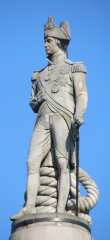
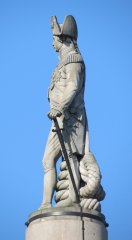
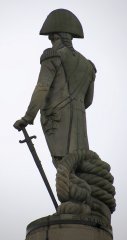
The statue itself shows Nelson in iconic pose, standing with the empty sleeve of his missing right arm pinned against his jacket, his other hand on the pommel of his down-pointing sword. He has a decoration on his hat, and further medals on his chest (you will need to click on the pictures to enlarge to see these properly). Behind him is a coil of rope, set there both to give a maritime setting on a scale large enough to notice from the ground far below, and to provide additional structural support for the huge, heavy stone statue.
The sculptor, E. H. Baily, born in Bristol, studied under Flaxman, and specialised in portraiture, though he has some monumental and allegorical work - see note on the page devoted to him.
The Column by William Railton, showing lions, Canada House, and National Gallery.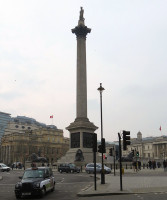
Nelson's Column - the column itself that is was designed by the architect William Railton, and is fluted (grooved) and of the Corinthian order (see picture at top of this page). We may note in passing that London's other great statuary column, the York Column, is only a short distance away in Waterloo Place off the Mall to the west of Trafalgar Square. That one was put up a few years before Nelson, and is plain and Doric - Benjamin Wyatt was the architect.
At the base of the column are four great bronze plaques. The Battle of St Vincent is by the sculptor M. L. Watson, completed after his untimely death by W. F. Woodington, whose own panel for the Column is the Battle of the Nile. John Ternouth was the sculptor of the Bombardment of Copenhagen, and the Death of Nelson is by J. E. Carew. The famous Landseer Lions have a page of their own on this website.
Flaxman's monument to Nelson in St Paul's Cathedral.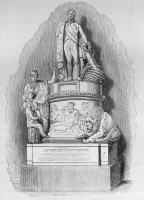
As one of the most important national heroes, there are several statues of Nelson elsewhere. St Paul s Cathedral s memorial to Nelson is by John Flaxman. This earlier statue shows Nelson standing with again a coil of rope next to him, but attached to an anchor, and the missing arm, emphasised in Baily s Trafalgar Square statue, is concealed by Flaxman under a draped cloak. The St Paul's Nelson is accompanied by a Britannia, two boys, lion, and a frieze of river gods. In the Guildhall there is another memorial group, with a mourning statue of Britannia seated on a lion, holding a plaque of Nelson s portrait; other figures and a frieze complete the busy composition. It is the work of the rather obscure sculptor James Smith. And in Greenwich, there is a pediment depicting the Immortality of Nelson, by the rather more renowned sculptor Benjamin West. There is in fact a preliminary model of the Trafalgar Square Nelson, somewhat over life size, in one of the Government buildings just down Whitehall, but not viewable by the public.
Yarmouth Nelson column, and Nelson statues in Birmingham, Liverpool, Portsmouth.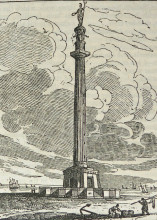
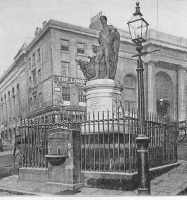
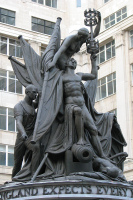
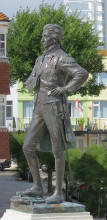
In Yarmouth is another Nelson's Column, the pillar being designed by William Wilkins, in a happy accident linking it to Trafalgar Square, for Wilkins was of course the architect of the National Gallery. It was put up in 1817-19, and is Doric and fluted. Although it bears the names of the ships Nelson commanded, and the battles he won, the summit is occupied not by a statue of Nelson, but of Britannia, her base supported on Caryatids. A very good Nelson statue is that of the Nelson Monument in Liverpool, which is particularly important, and has its own page on this site. Birmingham has a statue by Sir Richard Westmacott RA, without column, which being put up in 1809, was the only public statue in the city for many years. It shows him standing, arm outstretched, in front of the prow of a miniature ship, representing HMS Victory (for more ship sculpture, see this page). Alas, the original base with carving was lost. A rather slight bronze Nelson statue in Portsmouth is by the sculptor F. Brook Hitch, and needs mention because apparently the sculptor went to great lengths to ensure it was authentic in all respects. Among other Nelson statues, I would mention the rather weatherbeaten stone one in Norwich, which I am rather fond of, by the sculptor Thomas Milnes. Busts of Nelson are too numerous to mention, but we might note the one by Turnerelli, again in Norwich (in the Castle), and the Greenwich one outside the Naval Museum by Chantrey, as particularly fine ones.
Contemporary illustration of the building of Nelson's Column, 1842/3.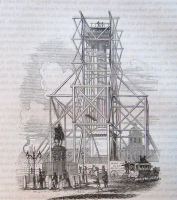
Trafalgar Square // Landseer's Lions at base of Nelson's Column